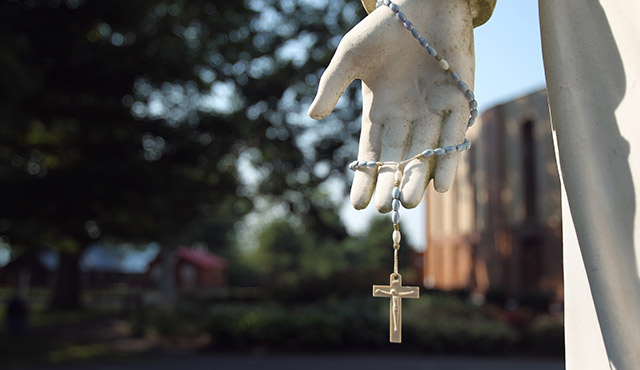The Rosary is one of the most beautiful prayers of the Catholic Church. It is one of the first prayers a child learns during faith formation and one of the most essential daily devotions for many faithful Catholics. Whether prayed with a group, such as during the early-morning rosary said weekdays at St. John Vianney Chapel on Balboa Island by a dedicated prayer group, or individually, it offers those praying it a chance to truly reflect on the life of Christ. Despite its popularity, the origins of the structure of the rosary prayer and the rosary beads remain a mystery.
“There is one theory that the rosary beads might have come initially from Muslim tradition,” says Father James Heft, a Marian priest, historian and president of the Institute for Advanced Catholic Studies at the University of Southern California. “There are prayer beads that are used in Hinduism and there’s certain prayer beads that are used in Islam.”
Father Heft credits a historical timeline for this theory.
“The Dominicans really promoted the rosary,” he explains. “Islam was founded several hundred years before the time of Dominic. Dominic was in the 13th century and we know that there are several reasons why Dominic promoted the rosary. One was to oppose what was called the Albigensian heresy.”
The Albigenses was a group that successfully spread their doctrine across Europe during the 12th century. They rejected several Catholic beliefs concerning the Holy Trinity, Incarnation, the sacraments, as well as Mary as the Mother of God, to name a few. Saint Dominic Guzman, founder of the Dominican order, worked to combat this heresy by educating and sending priests throughout Europe to preach against it through the praying of the rosary. Saint Dominic is also associated with a legend that the Blessed Mother gave him the beaded rosary in a vision. However, according to Michelle Arnold, staff apologist for Catholic Answers, “the Blessed Virgin’s psalter predates Dominic, though he and the Dominicans became its principal promoters,” she wrote in an article in 2014. Many church scholars cannot seem to agree on the origin but numerous popes throughout history have advocated that St. Dominic was the illustrator of the rosary.
“There are other stories that seem credible and in the medieval period when there were a lot of people that were not literate, there were monasteries nearby and they knew that the monks prayed 150 psalms,” explains Father Heft. A group of lay brothers called the conversi, who couldn’t read the psalms, would pray with the monks. The conversi needed a simple prayer that could be remembered. The Our Father was chosen as the first prayer and they used the rosaries to keep count. At that time, the rosaries were referred to as the Paternosters, or Our Fathers. By the 12th century, the rosaries were used to count Hail Marys.
“The Rosary really became prominent with the defeat of the Muslims in 1571,” says Father Heft. “And at that time, Pope Pius V, who was a Dominican, attributed the victory over the Turks to praying the rosary. The following year, in 1572, he instituted an annual celebration of the rosary. Then in 1573, he made a Feast of the Holy Rosary in the liturgical calendar. And that was eventually moved to October 7.”
The Rosary promoted by Pope Pius V was made up of 150 beads. It evolved into the now popular version of the rosary that has 50 beads. A mystery reflecting on the life of Jesus and Mary separates each decade. There are five mysteries in each of the four sets of mysteries. Originally there were three sets of mysteries: Joyful, Sorrowful and Glorious. The Joyful Mysteries reflect on the annunciation of Jesus’ birth by the angel Gabriel to Mary and the birth and childhood of Jesus. The Sorrowful Mysteries encompassed Christ’s passion and death. And the Glorious Mysteries reflect on the Jesus’ Resurrection and Ascension, as well as the Assumption and Coronation of Mary. By 2002, yet another revision was to be added to the ancient prayer.
“John Paul II created the fourth set called the Luminous Mysteries, the mysteries of Light,” says Father Heft. “I think it was a lovely creation on his part because what was missing was his public life. The original mysteries began with Jesus’ infancy, to suffering, to glory. So John Paul was really smart to create what are called the Luminous Mysteries.”
Although the exact origins of the beaded rosary are also itself a mystery, the devotion is what many Catholics turn to for many reasons.
“It connects with the scriptures and it helps support people in prayer,” says Father Heft. “We do know that after Vatican II in the ’60s it kind of fell off as a devotional prayer but it’s now coming back with a certain strength again. I think people needed help and needed some structure that supports them in prayer.”

